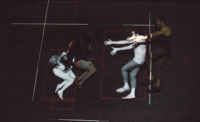Collective memory was the driving force behind the latest incarnation of the annual, temporary Serpentine Gallery Pavilion, by Swiss architects Jacques Herzog and Pierre de Meuron and Chinese artist-activist Ai Weiwei. To build a kind of manufactured archaeological site based on the previous 11 pavilions, the team created a drawing that fused the foundations of those structures into a single digital rendering, and then carved this form out of the ground. The three, who collaborated on the Bird's Nest Stadium for the 2008 Beijing Olympics, worked around Ai's house arrest by communicating via Skype. The subterranean 4,300-square-foot floor, consisting of overlaid geometric forms, is blanketed in compressed cork that fits together like pieces of a 3-D jigsaw puzzle. A massive dishlike steel roof supported by 12 steel columns wrapped in cork is a nod to the temporary canopies that cover fragile archaeological sites. It holds a shallow pool that reflects the neo-Georgian gallery across the lawn. Visitors can walk all over the pavilion's lower-level surfaces and can rearrange the movable stools and benches to create a makeshift stage, platform, or jungle gym, or simply sit quietly to take a breather from the bustle of the Olympics nearby.
Herzog & Meuron and Ai Weiwei's Serpentine Pavilion

Serpentine Gallery Pavilion
Herzog & de Meuron and Ai Weiwei
London
Image courtesy Herzog & de Meuron and Ai Weiwei

Serpentine Gallery Pavilion
Herzog & de Meuron and Ai Weiwei
London
Image courtesy Herzog & de Meuron and Ai Weiwei

Serpentine Gallery Pavilion
Herzog & de Meuron and Ai Weiwei
London
Image courtesy Herzog & de Meuron and Ai Weiwei

Serpentine Gallery Pavilion
Herzog & de Meuron and Ai Weiwei
London
Image courtesy Herzog & de Meuron and Ai Weiwei

Serpentine Gallery Pavilion
Herzog & de Meuron and Ai Weiwei
London
Image courtesy Herzog & de Meuron and Ai Weiwei

Serpentine Gallery Pavilion
Herzog & de Meuron and Ai Weiwei
London
Image courtesy Herzog & de Meuron and Ai Weiwei

Serpentine Gallery Pavilion
Herzog & de Meuron and Ai Weiwei
London
Image courtesy Herzog & de Meuron and Ai Weiwei

Serpentine Gallery Pavilion
Herzog & de Meuron and Ai Weiwei
London
Image courtesy Herzog & de Meuron and Ai Weiwei

Serpentine Gallery Pavilion
Herzog & de Meuron and Ai Weiwei
London
Image courtesy Herzog & de Meuron and Ai Weiwei

Serpentine Gallery Pavilion
Herzog & de Meuron and Ai Weiwei
London
Image courtesy Herzog & de Meuron and Ai Weiwei

Serpentine Gallery Pavilion
Herzog & de Meuron and Ai Weiwei
London
Image courtesy Herzog & de Meuron and Ai Weiwei


Post a comment to this article
Report Abusive Comment